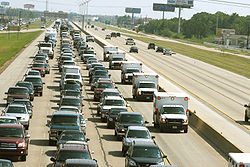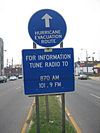- Emergency evacuation
-
For other uses, see Evacuation (disambiguation).
 Evacuees on Interstate 45 leaving Galveston, through Houston, during Hurricane Rita in 2005. Note how no south-bound lanes (right) were used as north contra-flow lanes for vehicles turning west.
Evacuees on Interstate 45 leaving Galveston, through Houston, during Hurricane Rita in 2005. Note how no south-bound lanes (right) were used as north contra-flow lanes for vehicles turning west.
Emergency evacuation is the immediate and rapid movement of people away from the threat or actual occurrence of a hazard. Examples range from the small scale evacuation of a building due to a bomb threat or fire to the large scale evacuation of a district because of a flood, bombardment or approaching weather system. In situations involving hazardous materials or possible contamination, evacuees may be decontaminated prior to being transported out of the contaminated area.
Contents
Reasons for evacuation
Evacuations may be carried out before, during or after natural disasters such as:
- eruptions of volcanoes,
- cyclones
- floods,
- hurricanes,
- earthquakes or
- tsunamis.
Other reasons include:
- military attacks,
- industrial accidents,
- chemical spill
- nuclear accident
- traffic accidents, including train or aviation accidents,
- fire,
- bombings,
- terrorist attacks
- military battles
- structural failure
- viral outbreak
Planning
Emergency evacuation plans are developed to ensure the safest and most efficient evacuation time of all expected residents of a structure, city, or region. A benchmark "evacuation time" for different hazards and conditions is established. These benchmarks can be established through using best practices, regulations, or using simulations, such as modeling the flow of people in a building, to determine the benchmark. Proper planning will use multiple exits, contra-flow lanes, and special technologies to ensure full, fast and complete evacuation. Consideration for personal situations which may affect an individual's ability to evacuate. These may include alarm signals that use both aural and visual alerts. Regulations such as building codes can be used to reduce the possibility of panic by allowing individuals to process the need to self-evacuate without causing alarm. Proper planning will implement an all-hazards approach so that plans can be reused for multiple hazards that could exist.
Evacuation sequence
The sequence of an evacuation can be divided into the following phases:
- detection
- decision
- alarm
- reaction
- movement to an area of refuge or an assembly station
- transportation
The time for the first four phases is usually called pre-movement time.
The particular phases are different for different objects, e.g., for ships a distinction between assembly and embarkation (to boats or rafts) is made. These are separate from each other. The decision whether to enter the boats or rafts is thus usually made after assembly is completed.
Small scale evacuations
 An exit sign mandatory for buildings in the United States, showing the way to the nearest exit, with two emergency lights for electrical failure.
An exit sign mandatory for buildings in the United States, showing the way to the nearest exit, with two emergency lights for electrical failure.
The strategy of individuals in evacuating buildings was investigated by John Abrahams in 1994.[1] The independent variables were the complexity of the building and the movement ability of the individuals. With increasing complexity and decreasing motion ability, the strategy changes from "fast egress", through "slow egress" and "move to safe place inside building" (such as a staircase), to "stay in place and wait for help". The last strategy that is the notion of using a designated Safe Haven on the floor. This is a section of the building that is reinforced to protect against specific hazards, such as fire, smoke or structural collapse. Some hazards may have Safe Havens on each floor, while a hazard such as a tornado, may have a single Safe Haven or safe room. Typically persons with limited mobility are requested to report to a Safe Haven for rescue by first responders. In most buildings, the Safe Haven will be in the stairwell.
The most common equipment in buildings to facilitate emergency evacuations are fire alarms, exit signs, and emergency lights. Some structures need special emergency exit or fire escapes to ensure the availability of alternative escape paths. Commercial passenger vehicles such as buses, boats, and aircraft also often have evacuation lighting and signage, and in some cases windows or extra doors that function as emergency exits. Commercial emergency aircraft evacuation is also facilitated by evacuation slides and pre-flight safety briefings. Military aircraft are often equipped with ejection seats or parachutes. Water vessels and commercial aircraft that fly over water are often equipped with personal flotation devices and possibly life rafts.
Large scale evacuations
The evacuation of districts is part of disaster management. Many of the largest evacuations have been in the face of war-time military attacks. Modern large scale evacuations are usually the result of natural disasters. The largest peace-time evacuations in the United States to date occurred during Hurricane Gustav[citation needed] and the category-5 Hurricane Rita (2005) in a scare one month after the flood-deaths of Hurricane Katrina.
Hurricane evacuations
Main article: Hurricane EvacuationsDespite mandatory evacuation orders, many people did not leave New Orleans, United States, as Hurricane Katrina approached. Even after the city was flooded and uninhabitable, some people still refused to leave their homes.[2][3]
The longer a person has lived in a coastal area, the less likely they are to evacuate. A hurricane's path is difficult to predict. Forecasters know about hurricanes days in advance, but their forecasts of where the storm will hit are only educated guesses. Hurricanes give a lot of warning time compared to most disasters humans experience. However, this allows forecasters and officials to "cry wolf," making people take evacuation orders less seriously. Hurricanes can be predicted to hit a coastal town many times without the town ever actually experiencing the brunt of a storm. If evacuation orders are given too early, the hurricane can change course and leave the evacuated area unscathed. People may think they have weathered hurricanes before, when in reality the hurricane didn't hit them directly, giving them false confidence. Those who have lived on the coast for ten or more years are the most resistant to evacuating. [1]
Public transportation
Since Hurricane Katrina, there has been an increase in evacuation planning. Current best practices include the need to use multi-modal transportation networks. Hurricane Gustav used military airlift resources to facilitate evacuating people out of the affected area. More complex evacuation planning is now being considered, such as using elementary schools as rally points for evacuation. In the United States, elementary schools are usually more numerous in a community than other public structures. Their locations and inherent design to accommodate bus transportation makes it an ideal evacuation point.
Registries
Most local communities maintain registries for special needs individuals. These opt-in registries help with planning, as those that need government evacuation assistance are identified before the disaster. Registries used after a disaster are being used to help reunite families that have become separated after a disaster.[citation needed]
Enforcing evacuation orders
In the United States a person cannot be forced to evacuate under most conditions. To facilitate voluntary compliance with mandatory evacuation orders first responders and disaster management officials have used creative techniques such as asking people for the names and contact of their next of kin, writing their Social Security Numbers on their limbs and torso so that their remains can be identified,[4] and refusing to provide government services in the affected area, including emergency services.
Personal Evacuation Kits
In case of an emergency evacuation situation, it is important to have an individual emergency evacuation kit prepared and on hand prior to the emergency. An emergency evacuation kit is a container of food, clothing, water, and other supplies that can be used to sustain an individual during lag time. Lag time is the period between the actual occurrence of an emergency and when organized help becomes available, generally 72 hours, though this can vary from a few hours to several days. It may take this long for authorities to get evacuation shelters fully up and functional. During this time, evacuees may suffer fairly primitive conditions; no clean water, heat, lights, toilet facilities, or shelter. An emergency evacuation kit, or 72-hour kit, can help evacuees to endure the evacuation experience with dignity and a degree of comfort.
See also
- Civil defense
- Emergency Management
- Evacuation process simulation
- List of mass evacuations
- Air safety#Emergency airplane evacuations
- Shelter in place
References
- ^ Abrahams, John: "Fire escape in difficult circumstances", chapter 6, In: Stollard, 1994, "Design against fire".
- ^ "New Orleans rescues continue, but some won't go" NPR 9-6-05
- ^ "Rescuers urge residents to leave New Orleans" NPR 9-6-05
- ^ "Magic Marker strategy" New York Times 9-6-05
- Gershenfeld, Neil, Mathematical Modelling. OUP, Oxford, 1999.
- Hubert Klüpfel, A Cellular Automaton Model for Crowd Movement and Egress Simulation. Dissertation, Universität Duisburg-Essen, 2003.
- Stollard, P. and L. Johnson, Eds., "Design against fire: an introduction to fire safety engineering design", London, New York, 1994.
External links
- The International Emergency Management Society
- A bibliography for pedestrian simulation and evacuation dynamics
- Fire Safety Engineering Group at the University of Greenwich
- PESOS and BYPASS, research projects concerning the "Evacuation of Passenger Ships" (University Duisburg-Essen, Germany)
- Panic Simulation (Budapest University)
- Dirk Helbing's homepage
- City evacuation study, Tokyo Institute of Technology
- Decontamination - prior to evacuation where possible.
- Evacuation routes for the US by state.
Categories:- Safety
- Emergency management
- Disaster preparedness in the United States
Wikimedia Foundation. 2010.

